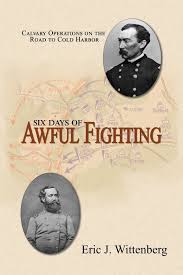Book Review: Six Days of Awful Fighting by Eric Wittenberg
 In his newest book, Eric Wittenberg has turned his prolific pen to a topic that has been unfortunately overlooked: the cavalry operations around Richmond during the 1864 Overland Campaign. Gordon Rhea gave the subject some much-needed attention in his book Cold Harbor, but the subject begged for a more detailed treatment. Fortunately, it was Wittenberg, a noted expert on cavalry operations during the war, who has turned his attention to it in his new book, Six Days of Awful Fighting: Cavalry Operations on the Road to Cold Harbor (Fox Run Publishing).
In his newest book, Eric Wittenberg has turned his prolific pen to a topic that has been unfortunately overlooked: the cavalry operations around Richmond during the 1864 Overland Campaign. Gordon Rhea gave the subject some much-needed attention in his book Cold Harbor, but the subject begged for a more detailed treatment. Fortunately, it was Wittenberg, a noted expert on cavalry operations during the war, who has turned his attention to it in his new book, Six Days of Awful Fighting: Cavalry Operations on the Road to Cold Harbor (Fox Run Publishing).
The depth of research in this work is impressive. Filled with fine detail, it contains a large number of personal quotes and anecdotes, as well as many obscure photographs of the major and minor players in the story. A huge bonus is the inclusion of 25 excellent and highly accurate maps created by the up-and-coming cartographer Edward Alexander.
The days before Cold Harbor were full of heavy cavalry activities, and Wittenberg goes into the details of the actions at Hanovertown, Haw’s Shop, Matadequin Creek, Hanover Court House and Ashland, as well as the cavalry’s role in the battle of Cold Harbor itself. The author points out that Federal commander Maj. Gen. Philip Sheridan sought to change the role of cavalry. Rather than using his horsemen for screening and scouting, he took advantage of their new rapid-firing carbines. They were used as shock troops–mounted infantry that could fight on foot with overpowering firepower. However, as Wittenberg demonstrates, this came with a cost: Union commander Lt. Gen. Ulysses S. Grant was deprived of his “eyes and ears,” and did not know the whereabouts of his adversary, Gen. Robert E. Lee. Federal infantry would pay a high price for this.
The Confederate cavalry had lost their commander, Maj. Gen. J. E. B. Stuart, who was mortally wounded at Yellow Tavern just a few weeks before. According to Wittenberg, Stuart’s successor, Maj. Gen. Wade Hampton, was quick to learn on the job.
Overall, this is a highly detailed and readable work. There are some things that could have used a closer edit, but they are few and far between. It is highly recommended as an excellent and much-needed study.
————
Six Days of Awful Fighting: Cavalry Operations on the Road to Cold Harbor
By Eric J. Wittenberg
Fox Run Publishing, 2020, $19.95 paperback.

I think Eric Wittenberg and Rhea are correct about Grant losing his “eyes and ears” at Spotsylvania CH, but they ignore the operational goal Grant was trying to achieve, and the principle Sheridan was trying to establish, ie, let the cavalry operate as an independent force and “i will whipt them”. The result of that first raid, incorrectly characterized as a mistake by Wittenberg, Rhea and the historians at Spotsylvania National Park was Stuart defeated, and the Confederate cavalry was not heard from for weeks. If you were worried as Grant was about the huge trains the AOP had, and were also still trying to draw Lee out into the open, the raid was a very logical decision, not at the tactical level, but at the operational level where Grant thought.